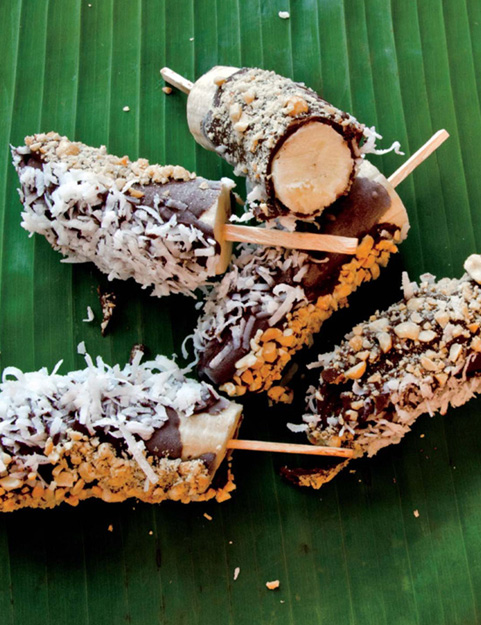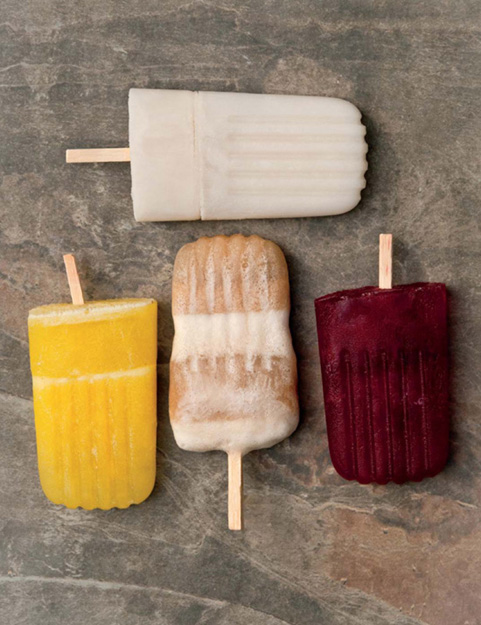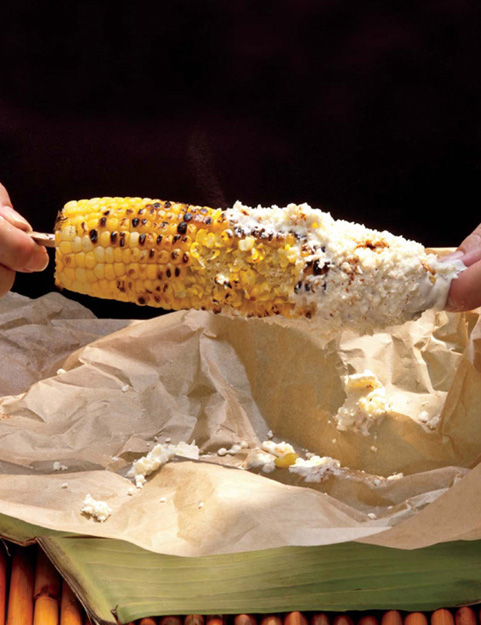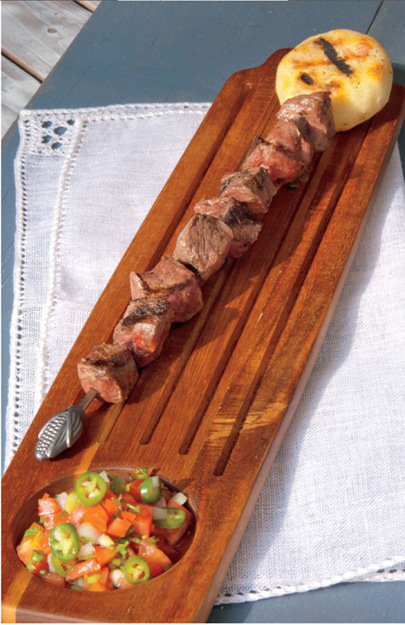An apple is just an apple, unless you put it on a stick and cover it with caramel, and then it achieves a new level of culinary heights. How something so ordinary can become extraordinary just by making it portable is fascinating to me.
My all time favorite street foods anywhere in the world are the fun and original renditions of corn on the cob served in Mexico and Guatemala. Some are buttered and then doused with lime juice; others are grilled until the kernels are charred and then sprinkled with spicy salt. Then there are those that are slathered generously with mayonnaise, sprinkled with crumbly cheese, and rolled in spicy chile powder. Mercy! I have stood in line waiting my turn to purchase one of these elotes locos many times in my life, and it never gets old. Part of what makes waiting to eat them so much fun is watching other people around me trying to eat theirs. Let’s just say that there is a lot of contorting and neck-bending that goes along with eating any of these decadent treatments of corn on the cob. The smiling faces of contented eaters, however, make it clear that these are worth the wait, the gymnastics required to eat them, and the mess.
On one of his voyages to the Americas, Christopher Columbus found the Taíno people of the New World cooking food on sticks over fire. They called it barbacoa, and today meat is cooked on sticks all over Latin America. Mostly, you’ll find kabobs, or pinchos, sold at stands near soccer fields, sports stadiums, beachfronts, and markets in Panama and South American cities. What makes Latin American kabobs most different from many you’ll eat in the United States is the fact that they are usually composed of only one ingredient at a time, that is, if you order a meat kabob, just meat is what you get. Likewise, if it’s a chicken kabob you want, you won’t find anything else threaded on the skewer with it.
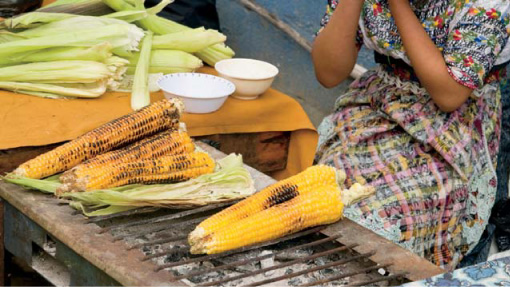
Elotes (grilled corn) sold from a makeshift grill.
Perhaps the most famous—or infamous, depending who you ask—of all Latin kabobs are the anticuchos that are sold late in the evenings on the streets of Lima. I say infamous because very few people outside of Peru know that the skewered meat that they’re eating is beef’s heart, and many would drop the stick at the mere mention of it. Before you decide to skip this chapter, know that if I’ve included a recipe here calling for beef’s heart, it’s because heart is completely succulent, but if you have any doubt, you can always use steak. Either way, you ought to try them and see what the big deal is. Soon you’ll discover why they’re so renowned.
When it comes to cooking kabobs, I prefer to use flat bamboo skewers that have an area wide enough to hold the meat in place. Whenever you cook with wooden sticks, be sure they’ve been soaked overnight in cold water so they don’t burn during the cooking process. There is no food on a stick more disappointing than the kind that ends up broken into charred pieces on the ground because the wood burned. You can always protect the ends of the sticks by wrapping them in aluminum foil. If you can find metal skewers, by all means use those. Just remember that they’ll remain hot long after the food is removed from them. And never, ever bite off pieces of food from a metal skewer. I’m just sayin’ . . .
The most famous food on a stick is cotton candy, known as algodón, and I remember going to many birthday parties as a child where algodoneros had been invited to make the spun sugar confection of different colors in front of our very eyes. The smell of hot sugar always makes me think of cotton candy. I recall being able to select among many different colored sugars. There was ballerina pink, parrot green, alabaster blue, egg yolk yellow, and grape-colored purple. I always chose pink. I know, it’s boring, but what can I tell you, other than little girls usually love pink. I remember clearly how the person making the candy would throw a plastic tablespoonful of the sugar of our choice into the drum of the machine. Then, if you stood quietly, you could hear the tiny grains of sugar hitting the revolving basin. They would make a tick, tick, tick sound that you could hear long before you could smell any sugar and long before any strands of cotton even began to take shape.
The excitement at the promise of the sweetness to come was hard to contain. All of a sudden, just like magic, little strands of sugar and thin wisps of candy would begin to appear. It never ceased to amaze me how that could happen. Then the aroma of sweet sugar would envelop my nostrils and the wad of cotton would begin to grow. Finally, the candy-maker would hold a stick to the inside of the drum, spinning and twisting it until a cloud as large as my head would envelop the stick. Every time I saw this, it made me think of the coiffed hair of little old ladies who tinted their gray hair funny shades of pastel colors. I don’t know why, but the image never failed to appear. To this day, I love the feeling of grabbing cotton candy between my fingers and taking it to my mouth, where it stays cottony for only a second or two before it melts into warm, sweet juice.
There are a few desserts on sticks that can rival cotton candy in Latin America, but if I had to choose one, chocolate covered bananas would top that list. The flavor of ripe, frozen bananas, coated with dark chocolate is a classic, and in Latin America you’ll find them further embellished with toppings such as crushed nuts, coconut, chocolate candies, or colorful sprinkles. You’ll find a very easy recipe for this treat in this chapter.
Though it might not rival cotton candy, the most famous dessert on a stick in Latin America is the paleta. This multicolored popsicle can be found all the way from Mexico down to Central America and comes in so many flavors that including them all in a book is impossible. However, I’ve put together an easy formula that works with many different flavors. I hope you’ll be inspired to go out and buy some popsicle makers so you can fill your freezer with these frozen sensations.
Food on a stick can still make me feel like a little girl. It makes me laugh, and it makes me happy. Get in touch with your inner child—you’ll be glad you did.
Chocolate-Covered Bananas (Chocobananos)
Chocolate-Covered Bananas (Chocobananos)
Many Latin American kids have experienced the pleasure of eating a perfectly frozen banana, coated in silky chocolate, and sprinkled with toppings. As a child, I could buy them from ice cream trucks. I made these often when my kids were little; now that they are all grow up, I still make them for myself. It’s important to freeze the bananas very well so that they’re sturdy when you dunk them into the chocolate; if they aren’t frozen solid, they’ll break into pieces. Once frozen, work swiftly—the chocolate sets quickly after they’re dipped. I’m told these keep well in the freezer for a few months, but I wouldn’t know because, in my home, they’re devoured immediately.
Serves 8
4 ripe but firm bananas, peeled and cut in half crosswise
8 popsicle sticks
12 ounces semisweet chocolate, chopped
1 cup flaked coconut
1 cup finely chopped unsalted roasted peanuts
Line a baking sheet with parchment paper. Insert a popsicle stick into each banana half; place them on the prepared sheet (so they aren’t touching each other). Freeze them until solid (for at least 3 hours up to 3 days).
Melt the chocolate on top of a double boiler over very low heat, stirring until smooth. Dip the frozen bananas into the chocolate; working quickly (or the chocolate will set), sprinkle one side of the banana with coconut and the other side with peanuts. Place the bananas back on the prepared sheet and freeze them again for 10–20 minutes before serving. Once frozen solid, these will keep well in a freezer-safe container or bag for up to 3 months.
Latin American Popsicles (Paletas)
Paletas, or Latin American popsicles, have taken the culinary scene by storm in the last decade. Some are made with fruit juices, others use frozen fruit pulps, and still others are made with mixtures similar to smoothies. In Latin America, popular beverages such as horchata and cinnamon iced tea are also transformed into popsicles. Paletas are sold all over the streets of Mexico and Central America, and they come in all sorts of flavors; mango and chile, chocolate and peanut, and lime and coconut are a few of my favorites. You’ll also find them in all colors of the rainbow. These are so simple to make that giving you a recipe feels a bit silly, so consider this more a set of guidelines than a recipe. The only equipment you’ll need is a blender and store-bought popsicle containers. Tropical fruit concentrates such as guanábana (soursop), mango, and tamarind make great popsicles. Puréed fruits also make delicious popsicles. For example, strawberries can be puréed, mixed with sugar, and strained through a sieve to remove any seeds before being frozen. My Pineapple Smoothies (page 327), Orangeade (page 332), Anise-Scented Limeade (page 329), Rice and Almond Milk Smoothies (page 323), Cinnamon Iced Tea (page 330), and Hibiscus Iced Tea (page 331) all can be turned into these luscious frozen treats. Be forewarned, though: once you start making paletas, you may not be able to stop!
Makes 6–8 popsicles
1 cup fruit concentrate or pulp (available frozen in Latin tiendas)
1 cup water
Sugar, to taste
2 teaspoons fresh lime juice
In a blender, combine the fruit concentrate, water, sugar, and lime juice. Blend until smooth and pour into popsicles containers. Freeze until solid.
Latin American Popsicles (Paletas)
Corn on the Cob with Cream and Cheese (Elotes Locos)
Corn on the Cob with Cream and Cheese (Elotes Locos)
Here, fire-roasted corn on the cob takes a bath in creamy sauce before it’s rolled in cheese and sprinkled with chile. Corn fixed this way is definitely the most famous food on a stick sold in Mexico and Central America. It’s called “crazy corn” because it’s drive-you-crazy delicious. Crazy corn is great fun to serve at parties and barbecues. Find sturdy skewers and offer plenty of napkins. Latin stores sell thick wooden sticks ideal for skewering through corn. Cotija cheese is the Parmesan cheese of Mexico, and it’s very easy to find in most American supermarkets; if you wish, you can use grated Parmesan or Pecorino Romano cheese instead. Buy corn at the top of the season when it’s fresh enough to eat raw. I briefly boil the corn first so it quickly chars before the sticks start to burn. You can grill the corn all the way if you prefer; just forgo the sticks and leave the stalk—nature’s stick—at the bottom of each cob. Wrap the stalks in aluminum foil to ensure that they don’t burn. Either way, this recipe is sensational and bound to drive you locos with its deliciousness. It’s impossible not to have fun while eating these. Make plenty for seconds; chances are, you won’t be able to stop at one.
Serves 12
12 ears (very fresh) corn on the cob (husked and stalks removed)
12 sturdy wooden skewers
1 cup Mexican crema or crème fraîche
1 cup mayonnaise
2 cups crumbled Cotija cheese (or Parmesan)
Ancho chile powder
Cook the corn in a large pot of boiling water for 3–4 minutes; remove from the heat, drain, and set aside. When cool enough to handle, insert a skewer in the bottom of each cob (see note).
Heat a grill (or indoor grill pan) until moderately hot. Grill the corn, turning the cobs often, until they are tender and slightly charred all over, about 4–6 minutes. In a large measuring cup, combine the crema and mayonnaise; set aside. Place the cheese in a shallow plate; set aside.
Wrap the bottom fourth of the cobs plus the skewers in aluminum foil so they’re easier to hold. Dip them into the crema mixture, coating them well, then roll in the cheese and top with chile powder (see note). Serve immediately.
NOTE: If you’re preparing these for a large crowd, you can blanch the corn and insert the skewers ahead of time. Cover and refrigerate for up to 8 hours. Heat the grill and continue with the recipe right before you serve them. Keep in mind that they may take a bit longer to char.
To make them easier to coat with the sauce, fill a tall glass half full with the dipping sauce and then let the guests dip and roll their own cobs, as they please. Place the chile powder in a jar with a sprinkle top.
Beef Skewers Bathed in Annatto and Orange (Carne en Palito)
These kabobs feature tender beef redolent of citrus and spices. In city streets, you’ll see them mounded on shiny trays—sometimes tented under aluminum foil—all lined-up, waiting to be cooked on makeshift grills built over barrels. Carne en palito literally means “meat on a stick,” and these truly mouth-watering kabobs are often sold during religious festivals and fairs. They’re sold by the beaches of Ecuador and outside the sports stadiums all over Panama City, where vendors compete for customers by offering delicious versions of these skewers. For less than a dollar each, you can go cart to cart, and sample them all. Wrapped in warm corn tortillas, these make spectacular appetizers, and they make a filling meal when paired with the Latin trinity: white rice, beans, and plantains.
Serves 8 as an appetizer or 4 as a main course
1 (1 1/2–1 3/4-pound) flank steak, sliced on the bias into 1/8-inch-thick strips
1 tablespoon finely grated orange zest
1 cup fresh orange juice
1/4 cup extra-virgin olive oil
5 large garlic cloves, minced
2 teaspoons annatto (achiote) powder or paste
1 1/2 teaspoons ground cumin
8 (12-inch) bamboo skewers, soaked overnight in cold water
Salt and freshly ground black pepper, to taste
In a large nonreactive bowl, whisk together the orange zest, orange juice, oil, garlic, annatto, and cumin. Add the beef and stir, making sure to coat it on all sides; transfer it to the refrigerator and marinate for at least 40 minutes (but no longer than 2 hours or the citrus will break down the beef, turning it mushy). Thread two to three slices of beef on each skewer; brush them with a bit of the marinade and discard the rest of the marinade. Heat a grill (or an indoor grill pan) until very hot. Grill the kabobs for 3–4 minutes per side or until well-done but still moist. (Latin Americans eat these well-done, but you can cook them for less time if you desire.)
Beef Kabobs in Beer Marinade (Chuzos de Carne)
Chuzo stands are abundant on the streets of Colombia, particularly around sports stadiums and during festivals. These kabobs offer deeply flavored beef that sizzles as soon as it comes into contact with hot grills. They’re usually grilled directly over makeshift coal fires. Although the kabobs in other cuisines feature different ingredients skewered between the pieces of meat, chuzos are all about the meat. The marinade helps to tenderize the beef while also infusing it with luscious flavor. On the streets of Guayaquil, small arepas are often speared at the end of each chuzo, collecting the juices that drip off the meat. At home, we love to eat these over a bed of Central American Red Beans and Rice (page 291) and dressed with a generous amount of Colombian Hot Sauce (page 279).
Serves 4
1 1/2 pounds beef tenderloin or flat iron steak, cut into 1-inch cubes
1 cup dark beer
1/3 cup extra-virgin olive oil
1 lemon, quartered
1/2 cup roughly chopped white onion
2 large garlic cloves, thinly sliced
2 bay leaves
1 1/2 teaspoon ground cumin
1/2 teaspoon dried thyme
Salt and freshly ground black pepper, to taste
8 (12-inch) bamboo skewers, soaked overnight in cold water
In a nonreactive bowl, combine the beef, beer, oil, lemon, onions, garlic, bay leaves, cumin, and thyme. Cover and refrigerate for at least 8 hours or overnight. Remove the beef from the marinade and pat it dry with paper towels; thread the pieces through the skewers (see note). Discard the marinade and season the beef with salt and pepper.
Heat an outdoor grill (or indoor grill pan) until very hot; cook the kabobs, turning them once in a while, until done to your liking (about 8–10 minutes for medium). Serve at once. See note.
NOTE: If you don’t have skewers, dry the beef well and heat 1 teaspoon of oil in a nonstick pan over medium-high heat; stir-fry the beef until it’s done to your liking (about 4 minutes for medium).
Chuzos make great party fare because they can be put together hours ahead of time and grilled at the last minute. After I discard the marinade and skewer the meat (or chicken), I cover and refrigerate the kabobs (this can be done 2–3 hours ahead of a party). When I entertain big crowds, I’ll triple or quadruple this recipe and grill the chuzos while my guests graze on appetizers. These go so well with a wide variety of the sauces in this book that I like to prepare an assortment of them. I present the multicolored sauces all lined up in little bowls so my guests can try them all.
Beef Kabob in Beer Marinade (Chuzo de Carne) with a Grilled White Corn Arepa (Arepa Blanca) (page 82) and Colombian Hot Sauce (Ají Colombiano) page 279)
Grilled Heart or Steak Kabobs (Anticuchos)
Late in the evenings on Lima’s streets, vendors begin to set up makeshift grills and signal the sale of these spicy and savory beef kabobs called anticuchos. They are traditionally made with beef’s heart and are served with a fun assortment of colorful sauces. Beef’s heart is flavorful, succulent meat, but finding it may prove difficult because American grocery stores don’t carry it, and in the Latin tiendas that do carry them, they sell out quickly. If you can, befriend your local farmers and ask them to save you one whenever they can. If, try as you may, you still can’t find the prized heart, make anticuchos with steak. The acidic marinade in this recipe breaks down the flesh of the heart, rendering it tender. If you use steak instead, marinate it only for a fraction of the time or it will become too soft. Anticuchos are often served with salsa criolla and spicy mayonnaise. The ají panca, a reddish-brown chile from Peru, can be found already ground to a paste in most Latin grocery stores. If you can’t find it, substitute equal amounts of Sriracha sauce. Serve these kabobs the way they do on the streets of Peru: with a generous amount of boiled yellow potatoes. Clean the heart, if using, by slicing it in half and removing any visible nerves and fat (or trim the steak). Slice the meat on the bias into 1/4-inch strips.
Serves 8
2–2 1/2 pounds beef heart or flat iron steak
1/2 cup red wine vinegar
2 teaspoons ají panca paste (or Sriracha sauce)
2 tablespoons minced garlic
1 teaspoon annatto (achiote) powder
1 teaspoon ground cumin
1 teaspoon salt
1/2 teaspoon freshly ground black pepper
1/2 teaspoon oregano
1/4 cup vegetable oil
8 (12-inch) bamboo skewers, soaked overnight in cold water
Peruvian Spicy Onion Salsa (page 275)
Spicy Mayonnaise (page 276)
2 pounds baby potatoes, boiled and halved
In a large nonreactive bowl, combine the vinegar, ají paste, garlic, achiote powder, cumin, salt, pepper, oregano, and vegetable oil. Add the meat, turning and tossing until well coated; marinate it for 8 hours (if using steak, marinate for 2 hours).
Thread the meat onto skewers and discard the marinade. Heat a grill (or indoor grill pan) until very hot. Grill the kabobs for 2–3 minutes per side (for medium-rare) or until the meat is done to your liking; top the meat with the Peruvian Spicy Onion Salsa and Spicy Mayonnaise; serve with the potatoes on the side.
Chicken on a Stick (Chuzos de Pollo)
Here, tender chicken is marinated in a mixture of herbs and spices before it’s threaded through skewers and grilled to perfection. You’ll find chicken kabobs sold on the streets in Colombia, Panama, and Ecuador. Depending on where you are, chuzos will be accompanied by salted potatoes called papas saladas or bowls of white rice. My favorite way to eat them, though, is with deliciously plump corn arepas. Using uniformly cut pieces of chicken allows these kabobs to grill evenly. Chicken breasts can sometimes taste dry, so I marinate them for a few hours before assembling the skewers so that the chicken can absorb the goodness of the flavors and remain moist as it cooks.
Serves 4
1 1/2 pounds chicken breasts, cut into 1-inch pieces
1/2 cup extra-virgin olive oil
1/3 cup fresh lime juice
2 large garlic cloves, minced
2 tablespoons minced flat-leaf or Italian parsley (leaves and tender stems)
1 teaspoon dried thyme
1 teaspoon ground cumin
2 bay leaves
Salt and freshly ground black pepper, to taste
8–10 (12-inch) bamboo skewers, soaked overnight in cold water
Grilled White Corn Arepas (page 82)
In a medium nonreactive bowl, combine the chicken, oil, lime juice, garlic, parsley, thyme, cumin, and bay leaves. Cover and chill for at least 2 hours (but no longer than 4 or the citrus will break down the flesh of the chicken, turning it mushy). Remove the chicken from the marinade and thread the pieces through the skewers. Discard the marinade and season the chicken with salt and pepper.
Heat an outdoor grill (or indoor grill pan) until very hot; cook the kabobs, turning them once in a while, until the chicken is cooked through on all sides, about 10–12 minutes (or until the chicken is no longer pink). Place an arepa at one end of each skewer. Serve at once.
